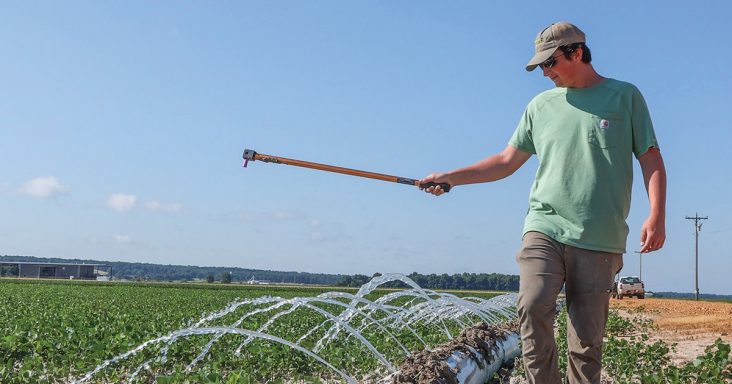Arkansas’ planted acreage plummets compared to March projections
by August 9, 2022 7:04 pm 1,182 views

Higher diesel fuel and fertilizer costs have reduced the number of real row crop acres planted in Arkansas in 2022, according to a report issued by the U.S. Department of Agriculture. Drought conditions in the northern and eastern parts of the state will likely add to the input costs and force some farmers to abandon even more fields meaning harvested acres will plummet further.
Yields will probably suffer this fall due to the lack of consistent rain.
“When you tally up the March-to-June difference for all crops – soybeans, rice, corn, cotton and peanuts – June acres are 155,000 less than March intentions,” said University of Arkansas agri economist Scott Stiles. “You’d think with the wet April conditions that soybeans would have been the beneficiary and come in higher than the March estimate. We had historically strong crop insurance guarantees this spring. As planting for our earlier crops got pushed against the final planting dates, it’s likely we had some acres go to prevented planting.”
There’s little doubt the number of acres will decline further as farmers begin to abandon fields as drought conditions worsen in August. The National Weather Service predicts temperatures are expected to remain above average through at least part of the harvest season.
Data for the USDA acreage report were derived from surveys conducted during the first two weeks of June. Acreage did fall from stated intentions, and two major crops, soybeans and cotton, rose from 2021 planted acreage. But recent reports from the USDA indicate that cotton acres are expected to drop by as much as 30% nationwide. How that will impact Arkansas’ cotton crop is uncertain.
“Rice, corn and peanuts were all lower,” Stiles said. “There was comparatively good price strength this spring across all commodities. Corn and soybean prices were at the highest levels since fall 2012, and cotton and rice prices were the highest since 2011.”
Arkansas soybean acres also fell slightly short of reported March intentions at 3.2 million acres. This still represents an increase of approximately 160,000 acres compared to 2021. Much of the nation’s soybean planting remains in the estimate stage due to slower planting in states such as Minnesota, North Dakota and South Dakota, where wet conditions slowed progress in late spring and early summer. Nationally, planted soybean acres rose about 1% to an estimated 88.3 million acres.
While planted acreage for all major commodities in Arkansas was at least slightly lower than reported intentions in March, peanut growers reported the most significant drop in acreage, falling more than 14% from 35,000 planned acres to 30,000 planted. In 2021, Arkansas growers planted 36,000 acres of peanuts.
Travis Faske, extension plant pathologist and acting peanut agronomist for the Division of Agriculture, said the drop in acreage didn’t surprise him.
“As cotton acreage increases, the peanut acreage is the inverse, typically,” Faske said. “Some reductions were due to rotation and others to more competitive prices in cotton and soybeans.”
Nationally, peanut acreage fell about 3%, to 1.54 million acres.
Despite recent surges in grain commodity prices, planted corn acreage fell to 710,000 acres from 2021’s 850,000 acres. The rise in fertilizer costs is the primary culprit. Jason Kelley, extension wheat and feed grains agronomist for the Division of Agriculture, said this year’s corn acreage was unsurprising.
“Arkansas producers cut some corn acres due to fertilizer prices, but weather delays also resulted in late planting that trimmed some acres from earlier intentions,” Kelley said.
Nationally, planted corn acreage fell about 4% to 89.9 million.
Arkansas’ planted rice acreage fell slightly from 2021, falling about 60,000 acres from last year’s 1.2 million acres and marking the lowest total rice acreage for Arkansas since 2013. Jarrod Hardke, extension rice agronomist for the Division of Agriculture, said overall rice acreage fell in line with his expectations.
“The small surprise was how low medium-grain acreage was as a part of that,” Hardke said. “Market demands suggested we would increase medium-grain acres, but instead we decreased.
“Acreage estimates were a big target throughout the winter and spring,” he said. “In December and into January it looked like 1.3 million acres were possible, before eroding with input costs and planting delays, which even reached the point of questioning if we would reach 1 million. Planting conditions and prices then improved to open the door to us exceeding 1.1 million.”
Nationally, planted rice acreage fell to 2.3 million acres from 2021’s 2.5 million.
Heavy rains in the spring had a significant impact on planting and now the lack of rain will likely impact crop quality. Since the first week in June it has rained less than an inch and half in Jonesboro, which sits in the center of the Arkansas Delta. It’s more than 70% less rain than normal for the months of June and July combined, the NWS reported.
All or parts of Fulton, Sharp, and Randolph counties are now classified as being in phase 3, or extreme drought, according to the U.S. Drought Monitor. It’s the second highest classification. Virtually every other county in the Arkansas Delta is now in phase 1 or phase 2 on the drought monitor.
Less rain means farmers will have to rely on more irrigation to water crops. This will increase input costs and impact yields. How much it will impact yields won’t be known until the harvest.
Abnormally high dry conditions in the upper Midwest could impact commodity prices as the harvest nears. Many farmers in this region rely on rain events to water crops and don’t irrigate. Parts of several Midwest states are in the abnormally dry category or in phase 1 drought, according to the U.S. Drought Monitor. Some parts are even in phase 2 or 3 drought. If drought conditions linger, soybean and corn yields in those states could drop which could lead to commodity price increases.
